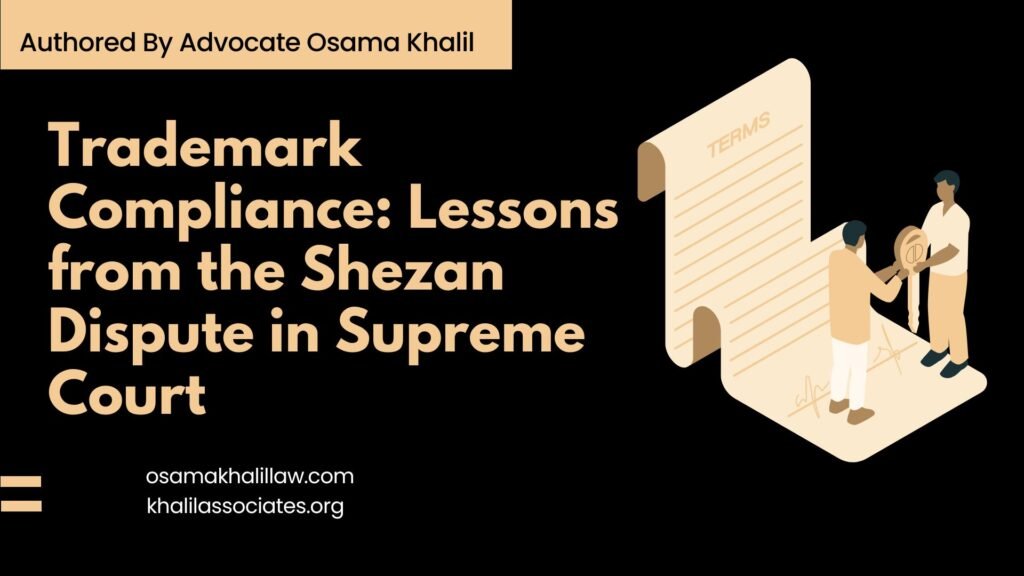
Trademark registration is a critical step for businesses to protect their brand identity. However, the process involves strict legal compliance to ensure that trademarks are unique, distinctive, and do not infringe on existing rights. The recent Supreme Court ruling in the Shezan trademark dispute highlights the importance of adhering to legal requirements during trademark registration. This article explores the key lessons from the case and provides guidance on achieving legal compliance for trademark registration.
The Importance of Legal Compliance in Trademark Registration
Legal compliance is the foundation of successful trademark registration. It ensures that a trademark meets all statutory requirements, avoids conflicts with existing trademarks, and provides the owner with enforceable rights. In the Shezan case, the Supreme Court of Pakistan emphasized that compliance with the Trade Marks Act, 1940, and the Revised Trade Marks Rules, 1963, is non-negotiable.
The court’s decision revolved around the principle of distinctiveness, a core requirement for trademark registration. A trademark must be capable of distinguishing the goods or services of one business from those of others. Without distinctiveness, a trademark cannot be registered, as seen in the Shezan dispute.
Key Legal Principles for Trademark Registration
The Shezan case sheds light on several legal principles that businesses must consider during trademark registration. A trademark must be unique and not identical or similar to existing trademarks. The court ruled that the respondent’s application for the “Shezan” trademark lacked distinctiveness, as the appellant already owned multiple registrations for the same mark.
Section 8(a) of the Trade Marks Act prohibits the registration of trademarks that may deceive or confuse consumers. The court found that allowing the respondent to register the “Shezan” trademark would likely mislead customers, as they might associate the respondent’s goods with the appellant’s well-established brand.
Section 10(1) of the Act bars the registration of trademarks that are identical or closely resemble existing ones. The court upheld this principle, stating that the respondent’s application violated this provision. Proper documentation and evidence are also crucial. The respondent’s failure to provide sufficient evidence to support its claims weakened its case. This highlights the importance of maintaining proper documentation, such as certificates of incorporation and partnership deeds, to prove ownership or succession rights.
Lessons from the Shezan Trademark Dispute
The Shezan case offers valuable lessons for businesses seeking to register trademarks. Before applying for registration, businesses must conduct a comprehensive search to ensure that their proposed trademark does not conflict with existing ones. This step helps avoid legal disputes and rejection of the application.
A trademark must be distinctive and capable of identifying the source of goods or services. Businesses should avoid using generic or descriptive terms that lack uniqueness. If an agreement involves the use or transfer of trademarks, it must clearly outline the terms and conditions. In the Shezan case, the 1975 agreement did not authorize the respondent to register the trademark, leading to its application being dismissed.
Businesses must keep accurate records, such as certificates of incorporation, partnership deeds, and assignment agreements, to prove ownership or succession rights. Proper documentation strengthens a business’s legal position and ensures compliance with trademark laws.
Steps to Achieve Legal Compliance for Trademark Registration
To ensure legal compliance during trademark registration, businesses should follow specific steps. First, they must choose a unique and distinctive trademark. Selecting a trademark that is original and not similar to existing ones is essential. Conducting a thorough search to verify its availability is a critical first step.
Next, businesses must file the application correctly. Submitting the trademark application with accurate details, including the class of goods or services and a clear representation of the mark, is vital. If the trademark office raises objections, addressing them promptly with supporting evidence and legal arguments is necessary.
After registration, monitoring the trademark for potential infringements and renewing it periodically to maintain its validity is crucial. These steps ensure that the trademark remains protected and enforceable over time.
Conclusion: Prioritizing Legal Compliance for Strong Trademark Protection
The Shezan trademark dispute serves as a reminder of the importance of legal compliance in trademark registration. By adhering to statutory requirements, ensuring distinctiveness, and maintaining proper documentation, businesses can protect their brand identity and avoid costly legal battles. The Supreme Court’s ruling reinforces the need for businesses to prioritize legal compliance, ensuring that their trademarks are not only registered but also enforceable in a court of law.
For businesses navigating the trademark registration process, understanding and implementing these legal principles is essential. By doing so, they can safeguard their intellectual property, build consumer trust, and establish a strong foundation for long-term success.
For professional assistance with Intellectual Property services and related legal matters, contact Osama Khalil, Lawyer & Legal Consultant. You can reach him at:
Phone: +92-316-1829946 | +92-307-2732223
Email: contact@osamakhalillaw.com | contact@khalilassociates.org
